
COAL TO ROXETH TO MAKE GAS
When the gasworks opened in 1855 the Harrow and Stanmore Gas Company at first received its coal in horse drawn carts from a Grand Union Canal wharf at Greenford Green, to which the coal was brought in horse drawn narrow-boats from the northern coalfields. Whilst it is not clear exactly where the location of the wharf was the journey from there to Northolt Road must have been both long and arduous especially in winter because of course such roads as Whitton Avenue did not exist and from the bottom end of Northolt Road although leading to Dabbs Hill Lane to reach the canal from there would have meant crossing farmland. So, did this mean the coal carts had to reach the works via the Greenford Road , Sudbury Hill and then down Roxeth Hill. Whatever route was taken it would have been both time consuming and expensive.

Horse drawn narrow boat

Narrow boats of the type used to transport coal and similar commodities. They usually travelled in pairs, operated by husbands and wives, with quite large families both being born on the boats and brought up. This scene at Watford around 1908 depicts empty boats on their way north and waiting for the lock to empty to the lower level.
No doubt due to all these factors, especially the cost, it was not long before the contract for coal supplies passed to the London and North Western Railway and coal was delivered to the works by cart from that company's goods yard at its Harrow ({later} and Wealdstone) station.
Deliveries by road became shorter still in 1880 when the Metropolitan Railway opened a goods yard at Harrow on the Hill, as part of its onward construction towards Aylesbury and beyond.
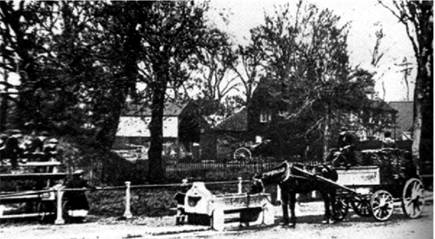
Taking a well earned drink at Bessborough Road believed to be a coal cart
The economic and social benefits of railway connections were in the minds of landowners, farmers and developers at Uxbridge where several railway acts of parliament although obtained had failed for various reasons and it was not long before they were making strong representation to the highly successful Metropolitan Railway for an extension from Harrow on the Hill to Uxbridge. This paid off and the line from Harrow to Uxbridge opened for traffic on 4 th July 1904. During the period of construction the Ealing and South Harrow Railway Company was also steadily making progress to reach its intended terminus at South Harrow from Mill Hill (now Acton Town) As this reached completion the Metropolitan realised the potential of a connection to this from its Uxbridge branch and opened a halt at Rayners Lane and commenced building a spur from there towards South Harrow. Although the distance was short, one mile 12 chains, the problems were large because the Roxeth Marshes had to be crossed. At first works commenced by building embankments but this was quickly abandoned due to them creeping outwards into the fields. The solution was found by building a viaduct comprising of almost seventy brick arches. This was completed by 1904 but because the two companies, by now the Ealing and South Harrow had been incorporated into the District Railway, could not agree running powers, through trains from South Harrow to Uxbridge did not commence until 1 st March 1910.
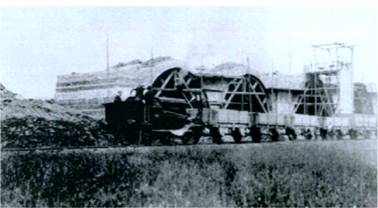
SOUTH HARROW VIADUCT UNDER CONSTRUCTION
During this period the management of the gas-works were quick to realise the potential of a railway line virtually on their door step and negotiations commenced with the Metropolitan Railway to build a spur from the viaduct at a point just south of where the line crosses Roxeth Green Avenue , into the works. This must have gone well as replacement and additional plant was provided in the gas-works between 1902 and 1911 in anticipation and these included the laying of rail sidings. The first coal train to the works ran on 4 th October 1910, by which time the amount of coal used for gas manufacture amounted to 18000 tons per year and the removal of this amount of traffic from the roads between Harrow and Roxeth offered considerable economies to the Gas Company and relief to the residents on the route.
The connection to the sidings was from the eastbound ( Rayners Lane to South Harrow) track just south of the cross-over used for by the South Harrow westbound passenger trains to cross to the eastbound track for their return journey. When passenger trains on the District Railway finally commenced running through to Uxbridge is was necessary to provide control between South Harrow and Rayners Lane signal boxes, it is not clear from maps and records of the period because some show this as a signal box and others as a ground frame. This was commissioned on 4 th October 1910 and comprised a total of 16 levers of which two were spare
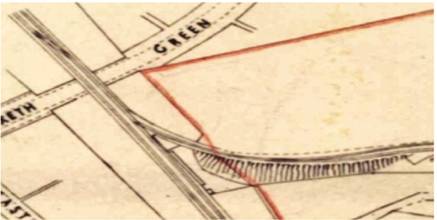
SECTION SHOWING GASWORKS SIDING CONNECTION ON THE VIADUCT THE RED LINE IS THE BOUNDARY OF GASWORKS PROPERTY Courtesy National Grid Archives
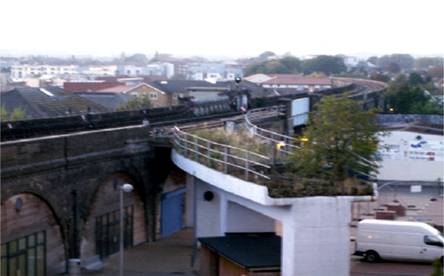
REMAINS OF THE GASWORKS "SPUR" CONNECTION ON ROXETH VIADUCT 2011 PHOTO PAUL TURNER
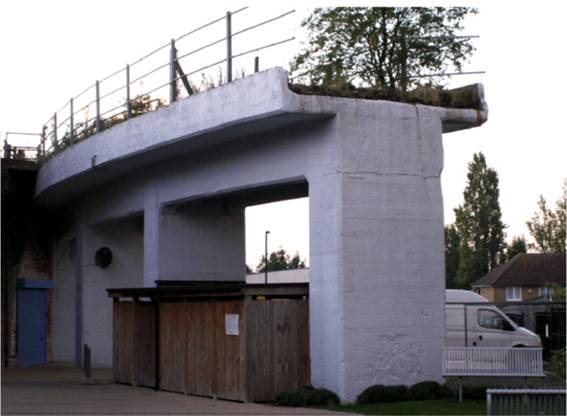
VIEW OF THE REMAINS OF THE GASWORKS SPUR FROM ROXETH GREEN AVENUE 2011
PHOTO PAUL TURNER
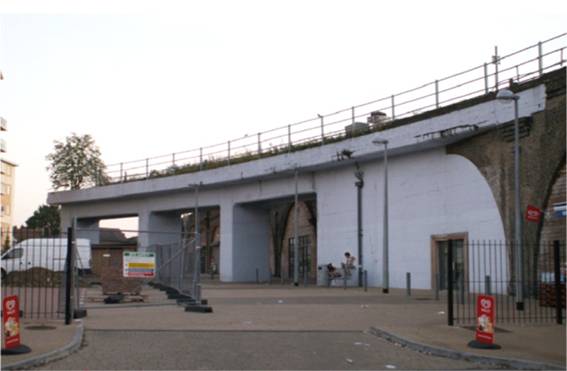
THIS IS THE ONLY REMAINING TRACE OF HARROW GASWORKS IN 2011
PHOTO PAUL TURNER
Following the formation of the London Transport Passenger Transport Board (LTPB) in 1933 whereby all London underground lines came under one umbrella and the extensive modernisation programme, especially in respect of signalling, this control point closed on 17 th November 1935.
From this date control of the sidings came from the panel in the new signal box at Rayners Lane where as part of the modernisation a new layout had been created which included a number of sidings for the coal yard at that station, reversing passenger trains and enabling the stabling of gasworks traffic until time permitted movements with minimum delays to passenger services.
At a point immediately to the Rayners Lane side of the bridge over Roxeth Green Avenue a relay room was constructed to the side of the viaduct supported on substantial steel girders.
This contained the controls required to operate the points and signals not only to provide access to the gasworks sidings but also to enable trains leaving the works to cross onto the westbound track to return in the right direction to Rayners Lane .
To reach the gasworks trains would on leaving Harrow on the Hill pass down the Uxbridge branch and on arrival at Rayners Lane would either stop in the westbound platform or be placed in a siding to await the movement towards South Harrow. When "given the road" the train would be propelled onto the South Harrow branch crossing from the west to east bound track on leaving the station, this was to ensure the locomotive was always at the leading end (out) whilst in the gasworks sidings. On arrival at the crossover leading into the gasworks the Rayners Lane signalman would be made aware from his illuminated track diagram that the train had arrived and was awaiting entry. The points would then be set in the direction of the siding and once the signal was cleared the train could then enter the gasworks. Once the movements in the works were completed the locomotive fireman would advise the signalman from the relay room and the process would be repeated to enable the train to leave only this time the movement would include crossing from the east to west bound track with the locomotive leading in the forward direction. On arrival at Rayners Lane the locomotive would be run round the train to enable the return to Harrow
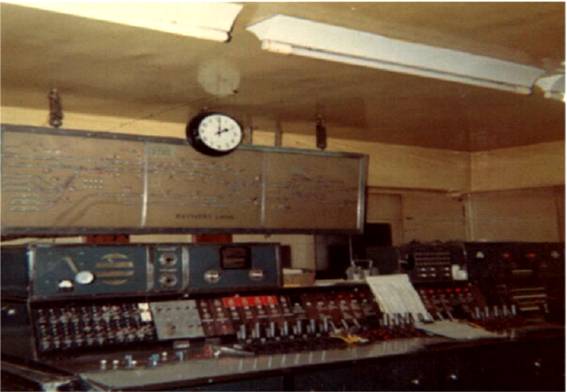
Control panel and track diagram - Rayners Lane Station signal box.

Section of the track diagram controlling the Gasworks sidings in Rayners Lane Station Signal Box

Remainder of the track diagram at Rayners Lane : Note the extensive siding connections.
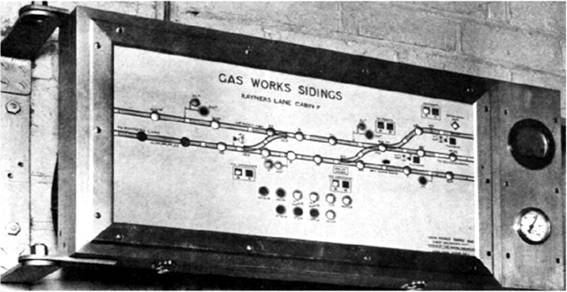
Repeater diagram in the relay room on the viaduct
This arrangement continued until the gasworks ceased producing gas on 3 rd April 1954 and the connection to the gasworks siding was completely abolished on 28 th July 1956. Should any reader have any photos of coal trains operating on the gasworks sidings or any information relating as to whether there was a signal box or ground frame controlling movements into the works, prior to remote control from Rayners Lane the author will be pleased to hear from them.
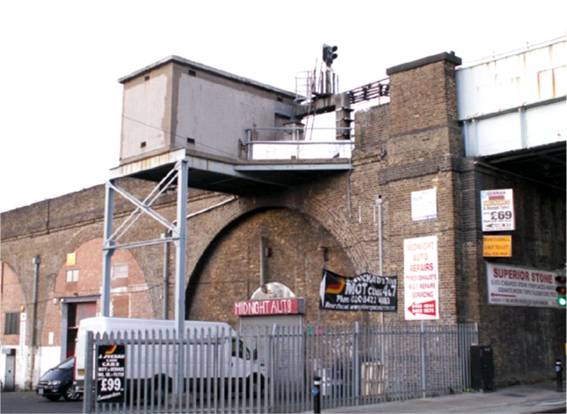
GAS WORKS SIDINGS RELAY ROOM 2011 -VIEWED FROM ROXETH GREEN AVENUE
PHOTO PAUL TURNER
The sidings inside the gasworks were quite extensive and not only permitted the delivery of coal to the point to where it was consumed but enabled the removal of ash, and the many by-products created as the result of coal gas manufacture. These included coke, tar and creosote

Section showing the extent of the sidings within the gasworks: Courtesy National Grid Archives
At first the coal was conveyed in trains solely operated by the Metropolitan Railway. Because of the requirement to propel the trains from Rayners Lane to the gasworks, and the fact that there were no run round facilities within the works, these had to be limited to 20 wagons, these were usually hauled by one of the MET's own class F 0-6-2 tank engines. The class F locomotives were painted in the Metropolitan dark red livery which later on was continued into London Transport days. There were certainly coal trains into the works every day and often two were required.
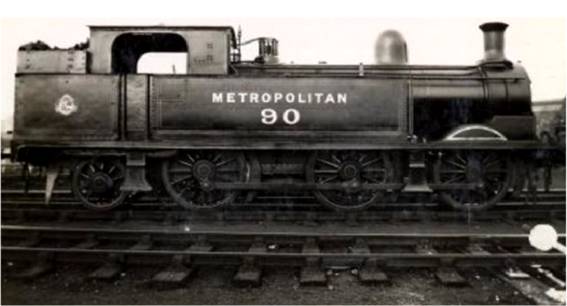
Metropolitan Railway Class F 0-6-2 Locomotive No. 90
In 1937 London Transport handed over nearly all of their steam locomotive duties including the gasworks trains to the London and North Eastern Railway Company (LNER) and consequently of the nationalisation of the railways in 1947 to the Eastern Region of British Railways. The wagons then would be brought from the coalfields to the British Railways yard at Neasden and then formed into 20 wagon trains which would then travel on British Railway lines alongside the MET to Harrow and then onto the Uxbridge branch to Rayners Lane and thence to the gas-works via the South Harrow branch and the spur..
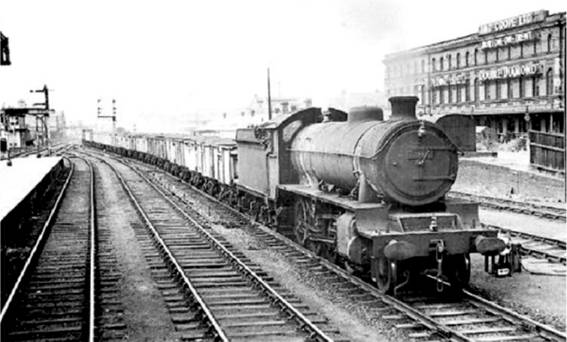
LNER Coal Train on route to London